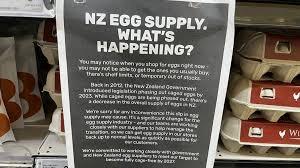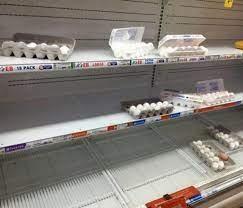 In a self-inflected wound, consumers in New Zealand are facing both high prices for eggs and a severe shortage. In 2017 the Government, prompted by welfare organizations banned conventional cages with a projected date of transition to alternative housing on December 31, 2022. The national flock at the time of the decision comprised 3.0 million hens. Given a population of 5.1 million, New Zealand consumers represented a relatively low annual consumption of 175 eggs per capita.
In a self-inflected wound, consumers in New Zealand are facing both high prices for eggs and a severe shortage. In 2017 the Government, prompted by welfare organizations banned conventional cages with a projected date of transition to alternative housing on December 31, 2022. The national flock at the time of the decision comprised 3.0 million hens. Given a population of 5.1 million, New Zealand consumers represented a relatively low annual consumption of 175 eggs per capita.
Due to the cost of conversion and disinclination by many farmers to continue producing eggs, the national flock has fallen to 2.5 million hens. This 16 percent reduction would be equivalent to 50 million hens in the U.S. Currently 10 percent of the national flock is still in conventional cages, 33 percent in enriched colony modules, 24 percent in barns and 33 percent as free range.
Disruption of supply following well-intentioned lobbying to ban cages and a fragmented industry has resulted in the present situation of undersupply with resulting high prices. Given the pristine flock health status of New Zealand, importation of commercial shell eggs is not a consideration

It is evident that production will eventually increase in response to demand but producers will have to receive a fair price for their product to allow for both fixed and variable costs. Inflation in the price of ingredients, fuel, power and packaging will require higher ex-plant prices and restraint on the part of supermarket chains in determining margins. If consumption in New Zealand were to be raised by 70 eggs per capita to 240, the national flock would increase to 4.2 million hens. It would appear practical for expansion to be achieved through enriched colony modules and barn housing, including housing for 300,000 hens still in conventional cages requiring an additional 2 million hen places.